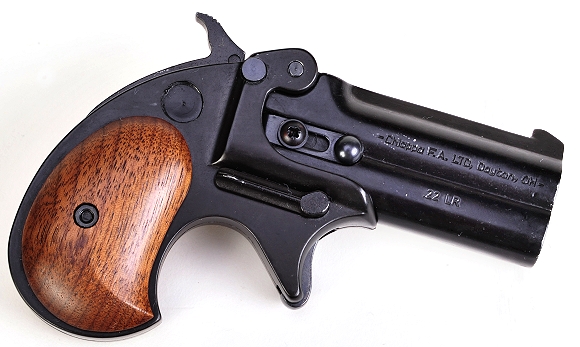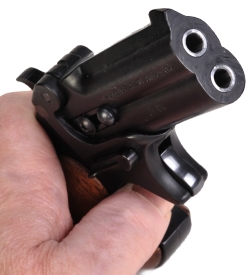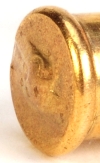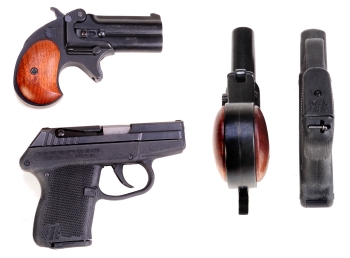A recent issue of Handguns & More Handgun attempted to represent the usefulness of a rather large laser sight, attached to a very small derringer. Amazing what ad dollars can produce in the way of editorial coverage in some publications. The truth of the matter is, outside of being interesting gadgets, and sometimes mandatory equipment for CAS, derringers seem a dramatically compromised solution for virtually every application.
Derringers are awkward to hold, they are comparatively oversize for any chambered cartridge, the actions are generally weak, the triggers are mechanically complex, and it takes six or seven hours to dump empties and reload. Chambered to follow the current .410 shotshell trend, all the owner has to do is put on clown shoes and pop out of a tiny car to reach manifest destiny. But, hey, maybe that’s just me. In any event, I thought I would pick up a popular inexpensive model and see how it held up and performed.
Enter – The Chiappa Firearms Double Eagle Derringer

|
Manufacturer |
Chiappa Firearms |
| Country of Origin | USA |
| Model | Double Eagle |
| Type | Derringer |
| Caliber | .22 LR |
| Capacity | 2 rounds |
| Barrel | O/U Lined |
| Barrel Length | 2 7/8″ |
| Twist | 1:16″ |
| Frame | Chiappalloy |
| Weight | 13 oz. |
| Overall length | 4 7/8″ |
| Height | 3 3/8″ |
| Grip Width | 1 1/8″ |
| MSRP | $149 |
|
Weights and measures are actual |
|
The Chiappa Firearms Double Eagle Derringer is sold by the company of the same name, a U.S. subsidiary of Italy’s Chiappa Group. The is billed as an “affordable classic for the collector of historic type firearms”. Product marketing literature references the Remington Derringer which was produced from 1866 – 1935. Outside of several small steel stampings and barrel liners, the gun is made of Chiappalloy; aluminum, copper, magnesium, and iron die casting alloy which is a nice way of saying something akin to pot metal, a substance that is great for making… pots.
The first example of a Chiappa Firearms Double Eagle Derringer I received was returned to the distributor as damaged and missing accessory parts. The black finish has chipped off the barrel casting and the little plastic bag that was to contain the safety key lock was empty. The replacement gun had a key lock, but also the same finish problems. The packaging is retro graphics cardboard, the manual is a single piece of 8×10 paper, folded in fourths.

I’ve not before seen a gun with parts held together with sheet metal screws that are threaded directly into a frame and barrel casting. In this case, while a machine screw does secure the barrel to the frame, sheet metal screws secure the locking lever to the frame, the frame halves and the extractor to the barrel. I would tend to believe routine disassembly was not at the forefront of Chiappa’s thinking.
The gun is coil compression and torsion spring sprung, which is a good thing. The barrel/breech lock up is accomplished with a half round cam and lever. The gun’s barrels rattled after being fired twice and the breech face is more of the Chiappalloy magic. The firing pin is a vertical stamping that rides in the face of the gun’s hammer, shifting when cocked to alternate barrel firing. Trigger pull measured an aerobic 7 lbs 8 oz.

The hammer and sear surface engagement was crisp and there was no noticeable creep in the trigger release. The cross bolt safety was positive and the integral safety lock with mini spanner key worked as per the instructions. The carry instructions were a little ambiguous where suggesting that the chamber under the hammer and firing pin be kept empty. As the firing pin alignment alternates on firing, and there is no external mechanical indication of which barrel will fire. I would assume this means the gun should be carried with both barrels empty?
The geometry of the grip frame and hammer is such that this is a tough gun to cock and fire single handed. A lot of grip shifting is required, or using both hands to stabilize the gun when cocking the hammer. The problem is two fingers barely grasp the grip and the grip has to be held low to get an angle to facilitate cocking the hammer.

The Double Eagle was relatively easy to control when shooting, after the hammer was cocked and the gun was properly gripped. At seven yards, which is a long ways off for what is primarily a point and shoot gun, it was pretty easy to get two shots within an inch of one another, the lowest perhaps an inch above and to the right of the bullseye. The notch and blade sights are black on black and not exactly easy to pick up against any backgroud.
The gun’s manual indicates that proper ammunition includes .22 long rifle, longs and shorts – regular, high and hyper velocity. The case at the left with pressure distortion was typical with virtually all hyper velocity .22 LR ammunition.
Conclusion

For self defense, the derringer is a bust; harder to conceal than even the KEL-TEC P-32 autoloader. The KEL-TEC is smaller, thinner, easier to shoot and certainly better made. 7+1 shots of .32 ACP rather than two shots of .22 LR.
As a collector’s piece and/or maybe just a nifty little gun to own, this derringer is not slick, the design isn’t interesting and the quality of materials and workmanship are substandard by any measure. While I was writing this story and working through verification of safety and loading instructions, a little piece of bright metal fell out and the gun lost its half cock hammer position.
I don’t like to write negative reviews. I prefer to be more careful of the firearms I choose to review and I prefer to spend my time researching, testing and writing about guns that other enthusiasts might also enjoy or find useful. This gun I don’t like. I prefer one that has been sorted out for reliable use.

Email Notification